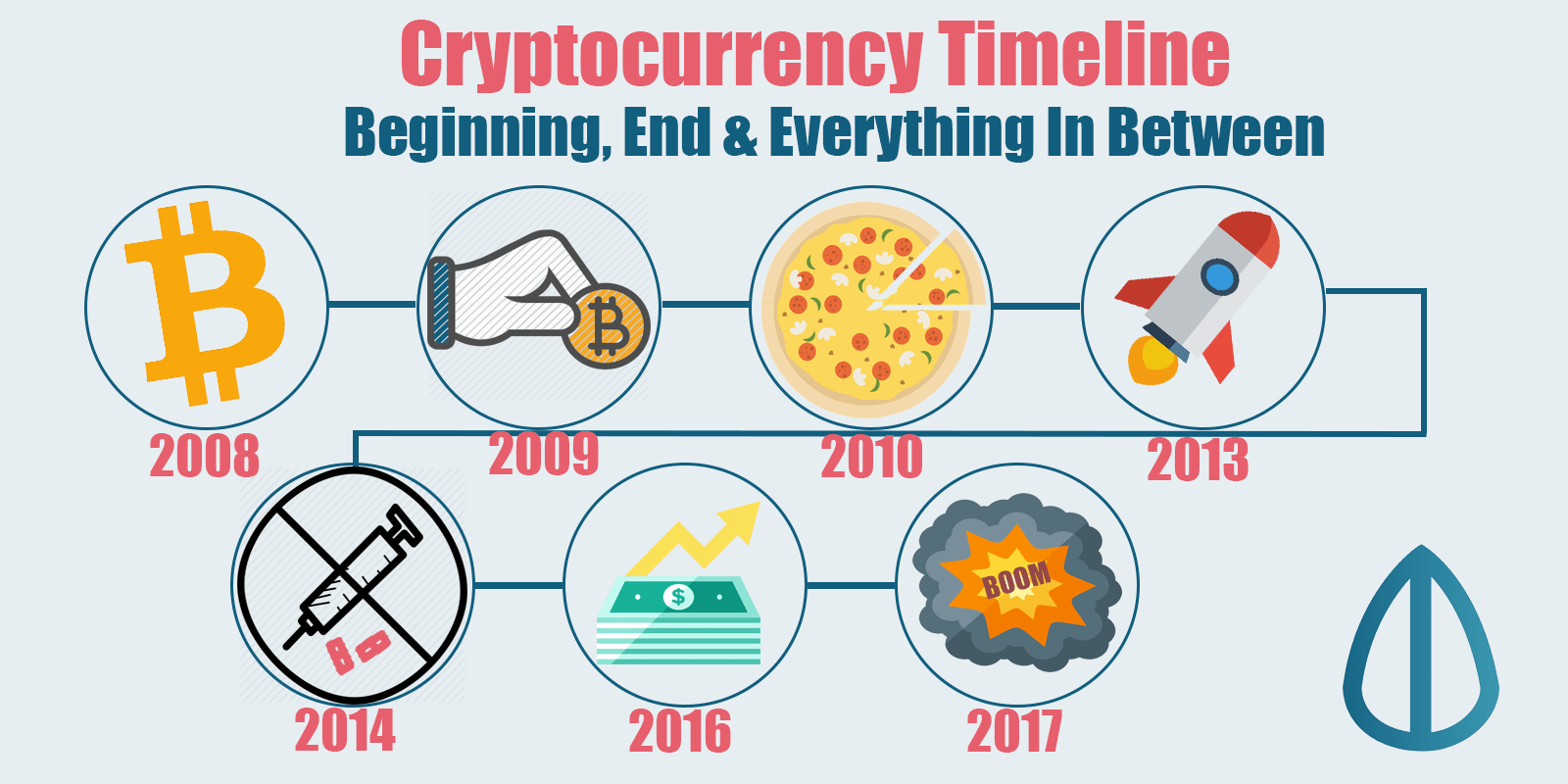
Cryptocurrency history is certainly short in the grand scheme of things, but there's been some incredible twists and turns since Bitcoin came on to scene back in 2008. Creating a entirely new technology (blockchain) and a cryptocurrency marketplace worth hundreds of billions, it's been an entertaining ride so far.
At TotalCrypto, we're going to keep you updated every month with interesting new developments (both comical and serious) in cryptocurrency with our timeline infographic.
If you'd like to see any particular key moments added to our infographic – please drop us an email via our contact page or comment below.
BeginnerOct 23, 2019
Fernandez 1 Yoandra Fernandez Professor Gomez Introduction to Information Technology February 13, 2021 History of Cryptocurrency The internet is a network tool that millions of individuals use every day. Whether it be on a desk top computer, laptop, tablet, or mobile device, the internet can be easily accessible to millions of individuals around the world at any time of the day. The history of crytpocurrency is actually a fairly short one. Yes, we have had digital currency systems before these cryptocurrencies existed, but they are not the same thing. As we mentioned on our 'Cryptocurrency Explained' page, former versions of digital currencies were strictly centralized, whereas these new forms of cryptocurrency, such as Bitcoin and Ethereum, are decentralized in nature.
Ten years ago, Bitcoin emerged as the first cryptocurrency. A lot has happened since that day – we would like to take a look back at some of the major events during this time period.
Bitcoin history starting point
The idea of having a digital currency is not a new one. Prior to cryptocurrencies, many attempts at creating one have taken place. The main issue most of them were facing, was the double spending problem. A digital asset somehow needs to be usable only once to prevent copying it and effectively counterfeiting it.

Over 10 years before cryptocurrencies, the concept had been introduced by computer engineer Wei Dai. In 1998, he published a paper where he discussed 'B-money'. He discussed the idea of a digital currency, which could be sent along a group of untraceable digital pseudonyms. That same year, another attempt by the name of Bit Gold was drafted by blockchain pioneer Nick Szabo. Bit Gold equally looked into creating a decentralized digital currency. Free 10 dollar slots. Szabo's idea was spurred by inefficiencies within the traditional financial system, such as requiring metal to create coins and to reduce the amount of trust needed to create transactions. While both were never officially launched, they were part of the inspiration behind Bitcoin.
The birth of Bitcoin, the first cryptocurrency
Satoshi Nakamoto published the white paper called Bitcoin: A Peer-to-Peer Electronic Cash System, describing the functionality of the Bitcoin blockchain network. This day in Bitcoin history has carved the path for the events that followed.
Four month later, Satoshi Nakamoto, whose true identity remains a mystery to this day, mined the first block of the Bitcoin network, effectively piloting the blockchain technology. Hannah brown bachelorette. The first mined block is also known as the Genesis Block.
The first recorded purchase of goods was made with Bitcoin when Laszlo Hanyecz bought two pizzas for 10,000 BTC. This day is still commemorated to date as the Bitcoin Pizza Day. At Ledger, we celebrated this with a limited edition Ledger Nano S.
The start of a cryptocurrency market
After the birth of Bitcoin as the first cryptocurrency, solutions had to be found in order to trade them. In March 2010, the first cryptocurrency exchange appeared in the name of bitcoinmarket.com (now defunct). In July that year, Mt.Gox was launched as well.
From 2011 to 2013, Bitcoin managed to reach parity with the US Dollar in February. During this year, a few rivaling cryptocurrencies emerged: By May 2013, the cryptocurrency market counted 10 digital assets, including Litecoin. Five dimes review. Another major crypto asset joined in August in the name of XRP (Ripple).
The Mt.Gox disaster

As the value of Bitcoin grew, the first hacks followed. In June 2011, Mt.Gox got hacked for the first time: 2,000 BTC was stolen, having a value of around $30,000 at the time.
Mt.Gox became the largest cryptocurrency exchange in 2013, at its peak handling 70% of all Bitcoin transactions.
Unfortunately in 2014, Mt.Gox became the first major cryptocurrency exchange hack, having 850,000 BTC stolen from it. This is the largest theft of BTC in Bitcoin history, which was valued at $460,000,000 at the time (current date value around $9,5 billion).
After this unprecedented situation, the Bitcoin price plummeted by 50% and did not recover to its initial value till late 2016. Cryptocurrency exchange hacks have remained ever-present since, though rarely of Mt.Gox's caliber.
Ethereum and the introduction of ERC-20 tokens.
On July 30th 2015, The Ethereum network was launched. Currently the second crypto asset in terms of market capitalization, it brought smart contracts to the cryptocurrency world. These allow the Ethereum blockchain to run an entire ecosystem on its blockchain while also hosting its own native currency: Ether (ETH). The smallest unit of Ether is also known as a Wei (0.000,000,000,000,000,001 ETH). If you want to know more about Ethereum, here is an article which explains everything you need to know about the second-largest cryptocurrency.
Cryptocurrencies that don't have their own dedicated blockchain, but use the blockchain of another crypto asset are known as tokens. The ones that are on the Ethereum network are called ERC-20 tokens. The first-ever ERC token launched back in 2015. That was the crypto asset known as Augur. Since that day, a plethora of tokens have been created on the Ethereum blockchain. There are currently more than 200,000 ERC tokens, which means that there is a huge cryptocurrency ecosystem running on a single blockchain.
From there on
The cryptocurrency world has not stood still since. Prices reached an all-time high in the bitcoin history in January 2018 and many new crypto assets have joined since, including EOS (July 2017), Tron (September 2017) and Cardano (October 2017). The cryptocurrency market currently hosts over 2000 digital currencies and is still expanding.
In fact, it is easy to see how cryptocurrencies are slowly but surely becoming global. The rising trend around crypto has led to more and more acceptance and use cases. Today, even the creation of a Central Bank Digital Currency (CBDC) is in progress and major companies show an increasing interest in blockchain and cryptocurrencies by investing into them. Obviously, those types of events will fuel a fast expansion of the market.
Crypto assets equally continued to gain popularity to a point where adoption has become more important and more present. The amount of Bitcoin ATMs has continued to increase, more shops have started accepting cryptocurrencies as a method of payment, crypto assets are being used as a form of fundraising and you could even travel around the world with crypto!

Cryptocurrency history is certainly short in the grand scheme of things, but there's been some incredible twists and turns since Bitcoin came on to scene back in 2008. Creating a entirely new technology (blockchain) and a cryptocurrency marketplace worth hundreds of billions, it's been an entertaining ride so far.
At TotalCrypto, we're going to keep you updated every month with interesting new developments (both comical and serious) in cryptocurrency with our timeline infographic.
If you'd like to see any particular key moments added to our infographic – please drop us an email via our contact page or comment below.
BeginnerOct 23, 2019
Fernandez 1 Yoandra Fernandez Professor Gomez Introduction to Information Technology February 13, 2021 History of Cryptocurrency The internet is a network tool that millions of individuals use every day. Whether it be on a desk top computer, laptop, tablet, or mobile device, the internet can be easily accessible to millions of individuals around the world at any time of the day. The history of crytpocurrency is actually a fairly short one. Yes, we have had digital currency systems before these cryptocurrencies existed, but they are not the same thing. As we mentioned on our 'Cryptocurrency Explained' page, former versions of digital currencies were strictly centralized, whereas these new forms of cryptocurrency, such as Bitcoin and Ethereum, are decentralized in nature.
Ten years ago, Bitcoin emerged as the first cryptocurrency. A lot has happened since that day – we would like to take a look back at some of the major events during this time period.
Bitcoin history starting point
The idea of having a digital currency is not a new one. Prior to cryptocurrencies, many attempts at creating one have taken place. The main issue most of them were facing, was the double spending problem. A digital asset somehow needs to be usable only once to prevent copying it and effectively counterfeiting it.
Over 10 years before cryptocurrencies, the concept had been introduced by computer engineer Wei Dai. In 1998, he published a paper where he discussed 'B-money'. He discussed the idea of a digital currency, which could be sent along a group of untraceable digital pseudonyms. That same year, another attempt by the name of Bit Gold was drafted by blockchain pioneer Nick Szabo. Bit Gold equally looked into creating a decentralized digital currency. Free 10 dollar slots. Szabo's idea was spurred by inefficiencies within the traditional financial system, such as requiring metal to create coins and to reduce the amount of trust needed to create transactions. While both were never officially launched, they were part of the inspiration behind Bitcoin.
The birth of Bitcoin, the first cryptocurrency
Satoshi Nakamoto published the white paper called Bitcoin: A Peer-to-Peer Electronic Cash System, describing the functionality of the Bitcoin blockchain network. This day in Bitcoin history has carved the path for the events that followed.
Four month later, Satoshi Nakamoto, whose true identity remains a mystery to this day, mined the first block of the Bitcoin network, effectively piloting the blockchain technology. Hannah brown bachelorette. The first mined block is also known as the Genesis Block.
The first recorded purchase of goods was made with Bitcoin when Laszlo Hanyecz bought two pizzas for 10,000 BTC. This day is still commemorated to date as the Bitcoin Pizza Day. At Ledger, we celebrated this with a limited edition Ledger Nano S.
The start of a cryptocurrency market
After the birth of Bitcoin as the first cryptocurrency, solutions had to be found in order to trade them. In March 2010, the first cryptocurrency exchange appeared in the name of bitcoinmarket.com (now defunct). In July that year, Mt.Gox was launched as well.
From 2011 to 2013, Bitcoin managed to reach parity with the US Dollar in February. During this year, a few rivaling cryptocurrencies emerged: By May 2013, the cryptocurrency market counted 10 digital assets, including Litecoin. Five dimes review. Another major crypto asset joined in August in the name of XRP (Ripple).
The Mt.Gox disaster
As the value of Bitcoin grew, the first hacks followed. In June 2011, Mt.Gox got hacked for the first time: 2,000 BTC was stolen, having a value of around $30,000 at the time.
Mt.Gox became the largest cryptocurrency exchange in 2013, at its peak handling 70% of all Bitcoin transactions.
Unfortunately in 2014, Mt.Gox became the first major cryptocurrency exchange hack, having 850,000 BTC stolen from it. This is the largest theft of BTC in Bitcoin history, which was valued at $460,000,000 at the time (current date value around $9,5 billion).
After this unprecedented situation, the Bitcoin price plummeted by 50% and did not recover to its initial value till late 2016. Cryptocurrency exchange hacks have remained ever-present since, though rarely of Mt.Gox's caliber.
Ethereum and the introduction of ERC-20 tokens.
On July 30th 2015, The Ethereum network was launched. Currently the second crypto asset in terms of market capitalization, it brought smart contracts to the cryptocurrency world. These allow the Ethereum blockchain to run an entire ecosystem on its blockchain while also hosting its own native currency: Ether (ETH). The smallest unit of Ether is also known as a Wei (0.000,000,000,000,000,001 ETH). If you want to know more about Ethereum, here is an article which explains everything you need to know about the second-largest cryptocurrency.
Cryptocurrencies that don't have their own dedicated blockchain, but use the blockchain of another crypto asset are known as tokens. The ones that are on the Ethereum network are called ERC-20 tokens. The first-ever ERC token launched back in 2015. That was the crypto asset known as Augur. Since that day, a plethora of tokens have been created on the Ethereum blockchain. There are currently more than 200,000 ERC tokens, which means that there is a huge cryptocurrency ecosystem running on a single blockchain.
From there on
The cryptocurrency world has not stood still since. Prices reached an all-time high in the bitcoin history in January 2018 and many new crypto assets have joined since, including EOS (July 2017), Tron (September 2017) and Cardano (October 2017). The cryptocurrency market currently hosts over 2000 digital currencies and is still expanding.
In fact, it is easy to see how cryptocurrencies are slowly but surely becoming global. The rising trend around crypto has led to more and more acceptance and use cases. Today, even the creation of a Central Bank Digital Currency (CBDC) is in progress and major companies show an increasing interest in blockchain and cryptocurrencies by investing into them. Obviously, those types of events will fuel a fast expansion of the market.
Crypto assets equally continued to gain popularity to a point where adoption has become more important and more present. The amount of Bitcoin ATMs has continued to increase, more shops have started accepting cryptocurrencies as a method of payment, crypto assets are being used as a form of fundraising and you could even travel around the world with crypto!
This list is expanding at a rapid pace, exactly like how the cryptocurrency prices went through the roof. Do not forget that three years ago, BTC's price was below 1000 USD!
Cryptocurrency History Timeline
With cryptocurrencies, you are able to 'be your own bank' – you are the only one in control of your digital assets and the only one in charge of keeping the secure.
The History Of Cryptocurrency
At Ledger, we lend a hand in protecting your valuable crypto assets by providing a secure solution that keeps the access to your cryptocurrencies offline and out of reach of hackers.

